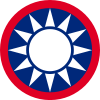Reorganized National Government of the Republic of China
| Republic of China | ||||||
| 中華民國 Chunghwa Minkuo Chūka Minkoku | ||||||
| Unrecognized State Puppet regime of the Empire of Japan | ||||||
| ||||||
| ||||||
| Motto 和平反共建國 "Peace, Anti-Communism, National Construction" | ||||||
| Anthem National Anthem of the Republic of China[1] | ||||||
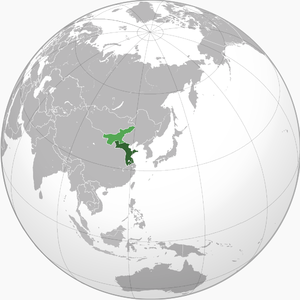 Dark green: Republic of China-Nanjing in 1939. Light green: Mengjiang (incorporated as a region in 1940). | ||||||
| Capital | Nanking | |||||
| Languages | Chinese Japanese | |||||
| Government | Republic | |||||
| President | ||||||
| - | 1940–1944 | Wang Jingwei | ||||
| - | 1944–1945 | Chen Gongbo | ||||
| Vice President | Zhou Fohai | |||||
| Historical era | World War II | |||||
| - | Established | 30 March 1940 | ||||
| - | Disestablished | 10 August 1945 | ||||
The Reorganized National Government was the name of the collaborationist government established in the Republic of China from 1940-1945.[2] It was led by the former Kuomintang (KMT) party member Wang Jingwei.
Wang Jingwei was the leftist leader of a Kuomintang faction called the Reorganizationists, who was often at odds with Chiang Kai-shek. After the fall of the capital city Nanjing to the Japanese army, the Nationalist government went into exile to Chongqing. On 30 March 1940, defectors under the tutelage of the Japanese army established a collaborationist government and claimed to be the legitimate representative of the Republic of China. The reorganized national government was formed out of previous collaborationist governments that existed in northern and central China, including the Reformed Government of the Republic of China based in eastern China, the Provisional Government of the Republic of China in northern China, and later on the Mengjiang government in Inner Mongolia, though in reality northern China and Inner Mongolia stayed relatively free of its influence. Although using the same state symbols and name of the republic, it enjoyed only international recognition by the Anti-Comintern Pact countries. The exiled nationalist government continued to be recognised by the rest of the world as the only legitimate representative.
The regime is therefore informally also known as the Nanjing Nationalist Government (Chinese: 南京國民政府; pinyin: Nánjīng Guó Mín Zhèngfǔ), the Nanjing regime, or by its leader Wang Jingwei regime (Chinese: 汪精衛政權; pinyin: Wāng Jīngwèi Zhèngquán). Other names used are the Republic of China-Nanjing, China-Nanjing, or New China.
The Republic of China led by the reorganized national government was effectively one of several Asian puppet states under Japanese control during the Second Sino-Japanese War (1937–1945), and it was meant to rival the legitimacy of the nationalist government. The reorganized national government declared war on the Allies on 9 January 1943. It was disbanded following the defeat of the Japanese military and the end of the war in August 1945.
Political boundaries

In theory, the Reorganized Government controlled all of China with the exception of Manchukuo, which it recognized as an independent state. In actuality, the Reorganized Government controlled only Jiangsu, Anhui, and the north sector of Zhejiang, all being Japanese-controlled territories after 1937.
Therefore, the Reorganized Government's actual borders changed as the Japanese gained territory in the war. During the December 1941 Japanese offensive, the Reorganized Government extended control over Hunan, Hubei, and parts of Jiangxi province. The port of Shanghai and the towns of Hankou and Wuchang were also under control of the Reformed Government after 1940.
The Japanese-controlled provinces of Shandong and Hebei were theoretically part of this political entity, although were actually administered by the Commander of the Japanese North Front, under a separate Japanese-controlled government based in Beijing. Like the Northern Front, the southern sectors had their own Japanese military commander and government based in Guangzhou. Each front acted as its own military unit with its own political and economic administration as well as its own Japanese military commander.
- Jiangsu: 41,818 mi² (108,308 km²); capital: Zhenjiang
- Anhui: 51,888 mi² (134,389 km²); capital: Anqing (also included the national capital of Nanjing)
- Zhejiang: 39,780 mi² (103,030 km²); capital: Hangzhou
According to other sources, total extension of territory during 1940 period was 1,264,000 km².
During the war, the Imperial Japanese Army committed numerous atrocities in areas controlled by the Reorganized Government, including so-called "mopping up" operations to frighten the populace. General Toshizō Nishio, the Commander-in-Chief of the Imperial Japanese Army's expeditionary forces in mainland China, was subsequently replaced by General Yasuji Okamura. On 9 September 1945, following Japan's defeat in World War II, the Japanese forces in the area surrendered to General He Yingqin of Chiang Kai-shek's National Revolutionary army.
Government, economy, education and everyday life
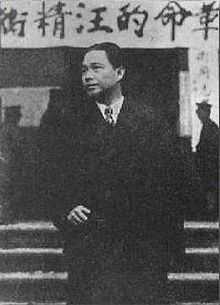
Government and political administration
The administrative structure of the Reorganized Government included a Legislative Yuan and an Executive Yuan. Both were under the president and head of state Wang Jingwei. Real political power remained with the Commander of the Japanese Army Central Chinese Front and Japanese political entities formed by the Japanese Counsellors. The Japanese also set up various local nationalist parties and movements to support its cause.
After obtaining Japanese approval to establish a national government, Wang Jingwei ordered the Sixth Kuomintang Representative Congress to establish this government in Nanjing. The dedication occurred in the Conference Hall, and both the "blue-sky white-sun red-earth" national flag and the "blue-sky white-sun" Nationalist Party flag were unveiled, flanking a large portrait of Sun Yat-Sen.
On the day the new government was formed, and just before the session of the "Central Political Conference" began, Wang visited Sun's tomb in Nanjing's Purple Mountain in an attempt to establish the legitimacy of his power as Sun's successor. Wang had been a high-level official of the Nationalist government and, as a confidant to Sun, had transcribed Sun's last will, the Zongli's Testament. To discredit the legitimacy of the Chongqing government, Wang adopted Sun's flag in the hope that it would establish him as the rightful successor to Sun and bring the government back to Nanjing.
The Nanjing Government and the northern Chinese areas
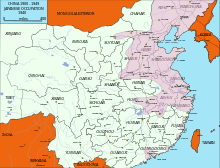
The Beijing administration (East Yi Anti-Communist Autonomous Administration) was under the commander-in-chief of the Japanese North China Front until the Yellow River area fell inside the sphere of influence of the Central Chinese Front. During this same period the area from middle Zhejiang to Canton was administered by the South Chinese Front. These small, largely independent fiefdoms had local money and local leaders, and frequently squabbled.
Wang Jingwei travelled to Tokyo in 1941 for meetings with his Japanese overseers. In Tokyo the Nanjing Government Minister and Vice president Chou Fo-hai commented to the Asahi Shimbun that the Japanese establishment was making little progress in the Nanjing area. This quote provoked anger from Kumataro Honda, the Japanese Ambassador and Consul in Nanjing. Chou Fo-hai petitioned for total control of China's central provinces by the National Government. In response, Imperial Japanese Army Lieutenant General Teiichi Suzuki was ordered to provide military guidance to Wang Jingwei's new regime at Nanking, and so became part of the real power that lay behind Wang's rule.
With the permission of the Japanese Army, a common monopolistic economic policy was applied, to the benefit of Japanese zaibatsu and local representatives. Though these companies were supposedly treated the same as local Chinese companies by the Government, the President of the Yuan legislature in Nanjing, Cheng Kung-po, complained that this was untrue to the Kaizo Japanese review. The Nanjing Nationalist Government of the Republic of China also featured its own an Embassy in Yokohama, Japan (as did the puppet-state of Manchukuo).
Notable people
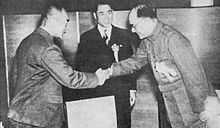
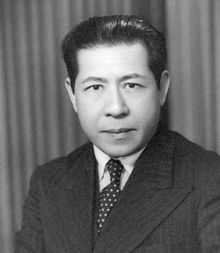
Local administration:
- Liang Hongzhi: President and Head of State in the initial period
- Wang Jingwei: President and Head of State
- Chen Gongbo: President and Head of State after the death of Wang. Also, President of the Legislative Yuan and Mayor of the Shanghai occupied sector.
- Zhou Fohai: Vice President and Finance minister in the Executive Yuan
- Jiang Kanghu Chief of the Education Yuan.
- Kumataro Honda: Japanese civil and political counselor of the local government and Japanese Ambassador in Nanjing
- Nobuyuki Abe: Japanese political adviser in the Chinese administration
- Teiichi Suzuki: military and political adviser in the Chinese administration
- Bao Wenyue: Minister of Military Affairs
- Ren Yuandao: Naval Minister
- Xiao Shuxuan: General Chief of Staff
- Yang Kuiyi: Minister of Military Training
- Li Shiqun: head of No. 76, the Wang Jingwei regime's secret service stationed in No. 76 Jessefield Road Shanghai
- Kaya Okinori: Japanese nationalist, merchant, and commercial adviser in the Chinese area
- Chu Minyi: national Ambassador in Yokohama, Japan
- Tao Liang: notable Chinese landowner and Chinese government official
- Chao Kung: (Ignaz Trebitsch-Lincoln), purported Buddhist leader
Foreign representatives and diplomatic personnel:
- Kumataro Honda: Japanese Ambassador and Representative
- Dr. Ernst Wörmann: German Ambassador
Economy
The local economy was administered primarily for the Japanese Army of the Central Front. Military planners installed an "occupation economy" with wartime money (Japanese Military Yen and native Chinese Yuan), and a Chinese Central Bank with supposedly Chinese entities, but all were administered by Japanese counsellors and the Japanese Army in the area. Chinese under the regime had greater access to coveted war-time luxuries, and the Japanese enjoyed things like matches, rice, tea, coffee, cigars, foods and alcoholic drinks, all of which were scarce in Japan proper. Additional entertainment, such as brothels, casinos and bars, were managed by the Japanese and local functionaries for the military. The purpose of this control was allegedly to impede the monetary depreciation of the yen, so as to maintain the strength of the Japanese currency on the continent.
In the Japanese-occupied territories, the prices of basic necessities rose substantially. In Shanghai of 1941, they increased elevenfold. Similar inflation occurred in Manchukuo, despite heavily centralized economic control by the Japanese.
Education
Education was similar across all the Japanese occupied territories. The strategy was to create a workforce suited for the factories and mines, and for manual labour. The Japanese also attempted to introduce their culture and dress to the Chinese. Complaints and agitation, as in Manchukuo, were raised and called for more meaningful Chinese educational development. Shinto temples and similar cultural centres were built in order to instill Japanese culture and values. These activities came to a halt at the end of the war.
Daily life
Daily life was often difficult in the Nanjing Nationalist Government-controlled Republic of China, and grew increasingly so as the war turned against Japan (c. 1943). Local residents resorted to the black market in order to obtain needed items or to influence the ruling establishment. The Japanese Kempeitai, Japanese Tokko, collaborationist Chinese police, and Chinese citizens in the service of the Japanese, all worked to censor information, monitored any opposition, and tortured enemies and dissenters. A "native" secret agency, the Tewu, was created with Japanese Army "advisors". The Japanese also established prisoner-of-war detention centres, concentration camps, and Kamikaze training centres to indoctrinate pilots as members of the Navy's Shanghai Kōkūtai (equipped with Mitsubishi A6M Reisen, Yokosuka K5Y, Nakajima B5Ns and some Seaplanes) and Nakajima/Kugisho L3Y1/2 of Tsingtao Base Squadron, detached in Tsingtao as part of Shina Homen Kantai (China Area Fleet) among Army s I/II Chutai of 85th Hiko Sentai and 9st Sentai (equipped with Ki-44 Shoki/Ki-84 Hayate) both units based in Shanghai and Nanjing area.
Media control
The Nanjing Government organized a "Bureau of Newspapers Management" under the "Department of Propaganda'" in October 1940. Four press agencies were created in 1941, though all were formally controlled by and censored by the Department of Propaganda.
Population
The population was probably close to the 1937–38 figures of the Interior Affairs Ministry, with no account taken of the outer regions or areas occupied by later advances:
- Jiangsu: 15,804,623
- Anhui: 23,354,188
- Zhejiang: 21,230,749
The populations of the major cities were:
- Nanjing: 1,100,000
- Shanghai: 3,703,430 (including 75,000 foreigners)
- Suzhou: 576,000
- Hangzhou: 389,000
- Shaoxing: 250,000
- Ningbo: 250,000
- Hankow: 804,526 (during its temporary control)
Other population estimates are as follows:
- Shanghai: 3,500,000
- Hankow: 778,000
Others sources during 1940 reported that the total number of inhabitants rose to 182,000,000.
National defense
The Japanese Army organized a local army, supposedly to defend the Nanjing Regime-controlled China. In reality, it served as a second line of offense and internal security as part of the Second Sino-Japanese war. A Collaborationist air force (the "Reformed Government of China Air Force" (1938) renamed the "National Government of China Air Force" in 1940) was created, and provided gliders for training purposes. It was later equipping with:
- Nakajima Ki-34 "Thora" for military activities and troop transport;
- Nakajima Ki-27b "Nate";
- Tachikawa Ki-55 "Ida" for training;
- Tachikawa Ki-9 "Spruce" for reconnaissance and training; and
- Nakajima Ki-43Ia Hayabusa "Oscar" for defence.
For the Collaborationist army, Japan provided:
- Type 94 TK Light Tanks
- Type 38 Year Meiji Carbines
- German Stahlhelm helmets, cannons, mortars, and light AA cannons
- Arisaka rifles, Type 99 Rifles and Nambu pistols.
For the Collaborationist navy, the IJN provided some captured warships:
- Gunboat Suma (Ex-HMS Moth)
- Gunboat Tatara (Ex-USS Wake)
- Gunboat Karatsu (Ex-USS Luzon)
- Gunboat Narumi (Ex-RM Ermanno Carlotto)
- Gunboat Okitsu (Ex-RM Lepanto)
- Gunboat Nan-Yo (Ex-Chinese Navy Teh Hsing)
- Patrol Boat PB-102 (Ex-USS Stewart)
- Patrol Boat PB-101 (Ex-HMS Thracian)
- Light Cruiser Isojima (Ex-Chinese Navy Ning Hai)
- Light Cruiser Yasojima (Ex-Chinese Navy Ping Hai)
.svg.png)
.svg.png)
The regime also had a regular police force under Japanese control. The local politicians and media consistently provided pro-Japanese propaganda, praising the "heroic efforts of the Imperial troops", and argued for a "national defence against Communism and Western interests".
Chiang Kai-shek's forces captured numerous members of Wang Ching-wei's army during military engagements. Enemy prisoners of low rank were persuaded to renege and fight alongside anti-Japanese forces, but high-ranking prisoners were executed. Leaders of the military included:
- Minister of Military Affairs: Bao Wenyue (鮑文樾)
- Minister of Navy: Ren Yuandao (任援道)
- General Chief of Staff: Yang Kuiyi (楊揆一)
- Minister of Military Training: Xiao Shuxuan (蕭叔萱)
Japanese methods of recruiting
During the conflicts in central China, the Japanese utilized several methods to recruit Chinese volunteers. Japanese sympathisers like Nanjing's pro-Japanese governor, or major local landowners like Tao-liang, were used to recruit local peasants in return for money or food. The Japanese recruited 5,000 volunteers in the Anhui area for the local Nanjing Army. Japanese forces and the Reformed Nanjing Government used slogans like "Drop Your Weapons, and Take the Plow", "Oppose the Communist Bandits" or "Oppose Corrupt Government and Support the Reformed Nanjing Government" to dissuade guerrilla attacks and buttress its support. Other methods included soliciting the cooperation of local bandits, using money, drugs, weapons, or captured goods as enticements. Using this system, they organized anti-guerrilla units, who sometimes collaborated with criminal elements.
The Japanese used various methods for subjugating the local populace. Initially, fear was used to maintain order, but this approach was altered following appraisals by Japanese military ideologists. In 1939, the Japanese army attempted some populist policies, including:
- dividing the property of major landowners into small holdings, and allocating them to local peasants;
- providing the Chinese with medical services, including vaccination against cholera, typhus, and varicella, and treatments for other diseases;
- ordering Japanese soldiers not to violate women or laws;
- dropping leaflets from aeroplanes, offering rewards for information (with parlays set up by use of a white surrender flag), the handing over weapons, or other actions beneficial to the Japanese cause. Money and food were often incentives used; and
- dispersal of candy, food and toys to children.
Buddhist leaders inside the occupied Chinese territories ("Shao-Kung") were also forced to give public speeches and persuade people of the virtues of a Chinese alliance with Japan, including advocating the breaking-off of all relations with Western powers and ideas.
In 1938, a manifesto was launched in Shanghai, reminding the populace the Japanese alliance's track-record in maintaining "moral supremacy" as compared to the often fractious nature of the previous Republican control, and also accusing Generalissimo Chiang Kai-Shek of treason for maintaining the Western alliance.
In support of such efforts, in 1941 Wang Jing-wei proposed the Qingxiang Plan to be applied along the lower course of the Yangtze River. A Qingxiang Plan Committee (Qingxiang Weiyuan-hui) was formed with himself as Chairman, and Zhou Fohai and Chen Gongbo (as first and second vice-chairmen respectively). Li Shiqun was made the Committee's secretary. Beginning in July 1941, Wang maintained that any areas to which the plan was applied would convert into "model areas of peace, anti-communism, and rebuilders of the country" (heping fangong jianguo mofanqu). It was not a success.
Primary industry statistics
Before and during Japanese control of the Reformed Nanjing Republic of China, the farming possibilities were as follows:
Winter wheat and kaoliang (sorghum) zones
- Precipitation: 24 in (600 mm)
- Growing period: 241 days
- Cultivated land area: 118,993 mile² (308,000 km²)
- Cultivated land area: 47% for winter wheat and 68% for kaoliang
- Cultivatable area per farm: 5.1 acres (21,000 m²)
- Percentage of peasant-tenants: 5%
- Peasant population density per unit area of cultivated land: 450/km² (1,165/mile²)
Distribution of crops
- Wheat: 46%
- Rice: 23%
- Corn: 16%
- Cotton: 9%
- Kaoliang: 19%
Distribution of animals
- Oxen: 40%
- Donkeys: 21%
- Mules: 16%
Transport types
- Loaders: 32%
- Hand carts: 36%
- Loader Animal: 21%
- Carts: 60%
Typical products
- Ziziphus
- Forages
Yangtze rice and wheat zones
- Precipitation: 42 inches (1070 mm)
- Growing period: 293 day
- Cultivated land area: 40,328 square miles (104,000 km²)
- Cultivated land area: 61% for rice and 25% for wheat
- Cultivatable area per farm: 3.5 acres (14,000 m²)
- Percentage of peasant-tenants: 25%
- Peasant population density per unit area of cultivated land: 525/km² (1,360/mile²)
Distribution of land usage for farming
- Rice: 58%
- Wheat: 31%
- Cotton: 13%
- Barley: 19%
Distribution of animal husbandry
- Oxen: 40%
- Water buffalo: 42%
- Pigs: 15%
Transportation distribution
- Loaders: 41%
- Hand carts: 22%
- Little vessels & boats: 33%
Typical products
- Bamboo
Land in cultivation
- Anhwei:
- Land in cultivation: 22.7%
- Cultivated land per person: 0.38 acres (1,500 m²)
- Kiangsu:
- Land in cultivation: 52.4%
- Cultivated land per person: 0.39 acres (1,600 m²)
- Chekiang:
- Land in cultivation: 26.3%
- Cultivated land per person: 0.30 acres (1,200 m²)
For mining resources, see Empire of Japan (natural resources, Asia mainland and Pacific areas, after 1937)
Industry & commerce
In pre-war Shanghai, many factories developed silk and cotton, and most had been controlled and owned by the Japanese or other foreign investors. A notable installation was the "Shanghai Power Plant" at the heart of the city, with a production capacity of some 200 megawatts. This power plant used coal from northern China. Since 1843 the port of Shanghai had been China's gateway for commerce, and in 1935, it was handling trade with New York, London, San Francisco, Kobe, Liverpool, Los Angeles, Hong-Kong, Hamburg and Rotterdam. Shanghai also had other industries that were crucial to modern Chinese society at that time. Even under Wang Jing-wei's regime it continued to be a major industrial and economic powerhouse.
To complement the efforts of the South Manchurian Railway Company, the Japanese civil establishment and the Imperial Japanese Army, in collaboration with Chinese local businessmen, founded the North China Railway Company. This had branches in Hopei, Shangtung and other Northern Chinese areas in order to link up the north China and central China railways. At about the same time the pro-Japanese government in Nanjing, together with "native" Japanese organisations and the Japanese Central Chinese Army authorities, organized the Central China Railway Company to link up the railways of Ahnwei, Kiangsu, north Chekiang, and areas near to or were held by the Southern Japanese Chinese Army, for economic and strategic reasons. The Japanese also organized a Chinese merchant shipping company and a Commerce Authority Entity for managing commercial traffic around Shanghai.
Japanese authorities reinforced monopolies on production in the occupied territories. Control methods were modelled on guilds, on the Naiga Wata Kabushiki Kaisha (which specialized in managing the Japanese cotton industry), or private zaibatsu such as Mitsubishi.
In Popular Culture
- Lust, Caution is a 1979 novella by Chinese author Eileen Chang which was later turned into an award winning film by Ang Lee. The story is about a group of young university students who attempt to assassinate the minister of security of the Wang Jingwei government. During the war, Ms. Chang was married to Hu Lancheng, a writer who worked for the Wang Jingwei government and the story is believed to be largely true.
- The 2009 Chinese film The Message is a thriller/mystery in the vein of a number of Agatha Christie novels. The main characters are all codebreakers serving in the Wang Jingwei regime's military, but one of them is a Nationalist Government double-agent. A Japanese Intelligence Officer detains the group in a castle and attempts to uncover which of them is the spy using psychological and physical coercion, uncovering the protagonists' bitter rivalries, jealousies, and secrets as he does so.
See also
- Manchukuo
- Dadao government (Shanghai 1937-1940)
- Second Sino-Japanese War
- History of the Republic of China
- National Revolutionary Army
- Collaborationist Chinese Army
- Organization of the China Garrison detachment of the Imperial Japanese Army (to 1937)
- Organization of Japanese Expeditionary forces in China
- Shanghai ghetto
- List of East Asian leaders in the Japanese sphere of influence (1931-1945)
- List of leaders of the Republic of China
References
- ↑ Japanese Newsreel with the national anthem on YouTube
- ↑ Narangoa, Li; Cribb, R.B. (2003). Imperial Japan and national identities in Asia, 1895–1945. Routledge. p. 13. ISBN 0-7007-1482-0.
Further reading
- David P. Barrett and Larry N. Shyu, eds.; Chinese Collaboration with Japan, 1932–1945: The Limits of Accommodation Stanford University Press 2001
- John H. Boyle, China and Japan at War, 1937–1945: The Politics of Collaboration (Harvard University Press, 1972).
- Bunker, Gerald E. Peace Conspiracy: Wang Ching-wei and the China War, 1937–41 (1972)
- James C. Hsiung and Steven I. Levine, eds., China's Bitter Victory: The War with Japan, 1937–1945 (Armonk, N.Y.: M. E. Sharpe, 1992)
- Ch'i Hsi-sheng, Nationalist China at War: Military Defeats and Political Collapse, 1937–1945 (Ann Arbor: University of Michigan Press, 1982).
- Frederick W. Mote, Japanese-Sponsored Governments in China, 1937–1945 (Stanford University Press, 1954).
- Joseph Newman, Goodbye Japan (references about Chinese Reformed Regime) published in New York, March 1942
- Edward Behr, The Last Emperor, published by Recorded Picture Co. (Productions) Ltd and Screenframe Ltd., 1987
- Agnes Smedley, Battle Hymn of China"
- Chiang Kai Shek, The Soviet Russia in China
- Wego W. K. Chiang, How the Generalissimo Chiang Kai Shek gained the Chinese- Japanese eight years war, 1937–1945
- Alphonse Max, Southeast Asia Destiny and Realities, published by Institute of International Studies, 1985.
- Jowett, Phillip S., Rays of The Rising Sun, Armed Forces of Japan's Asian Allies 1931–45, Volume I: China & Manchuria, 2004. Helion & Co. Ltd., 26 Willow Rd., Solihul, West Midlands, England.
External links
| Wikimedia Commons has media related to Reorganized National Government of China. |
- Nanjing Puppet Government National Flag
- Central China Railway Company Flag, under Japanese Army control
- Japanese occupation moneys
- Slogans, Symbols, and Legitimacy: The Case of Wang Jingwei's Nanjing Regime
| Preceded by Provisional Government of the Republic of China (1937–40) |
Reorganized National Government of the Republic of China 1940–1945 |
Succeeded by Nationalist government (1927–1948) |
| ||||||||||
.svg.png)
